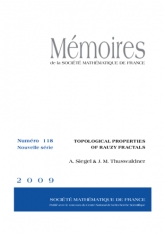Propriétés topologiques des fractals de Rauzy
Topological properties of Rauzy fractals

- Consulter un extrait
- Année : 2009
- Tome : 118
- Format : Électronique, Papier
- Langue de l'ouvrage :
Anglais - Class. Math. : 28A80, 11A63, 54F65
- Nb. de pages : 144
- ISBN : 978-2-85629-290-7
- ISSN : 0249-633-X
- DOI : 10.24033/msmf.430
Les fractals de Rauzy apparaissent dans diverses branches des mathématiques telles que la théorie des nombres, les systèmes dynamiques, la combinatoire et la théorie des quasi-cristaux. De nombreuses questions font alors intervenir la structure topologique des fractals. Cette monographie propose une étude systématique des propriétés topologiques des fractals de Rauzy. Les premiers chapitres de ce document rappellent les enjeux mathématiques relatifs aux fractals de Rauzy ainsi que les principaux résultats connus à leur sujet. Sont ensuite discutés des propriétés de pavages, de connexité, d'homéomorphisme à un disque, ainsi que le groupe fondamental de ces ensembles. Les méthodes s'appuient sur des résultats en topologie du plan et sur la construction de graphes pour décrire la structure des pavages associés aux fractals. De nombreux exemples caractéristiques sont présentés. Un chapitre final discute des principales perspectives de recherches liées à cette thématique.

